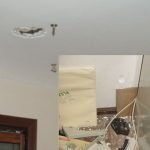Replacing a roof is tedious and costly, which is one good reason to try and preserve it for as long as possible. One way to provide protection and to make it last longer is to install a roof vent. With ventilation installed, you prevent moisture from seeping into various sections of your roof, which makes the wood rot eventually. Installing ventilation for your roof will require some labor but can be done on your own.
Materials/Tools/Equipment
You’ll need the following tools and equipment when you install a roof vent: safety goggles, chalk line, nails, circular saw, plastic roof cement, level, hammer, ladder, flat bar, exhaust vents, screws, putty knife, pencil, utility knife, screwdriver, intake vents, and a steel tape measure.
Note: Before you start to install a roof vent you should first check with the local authorities regarding local construction codes. Remember to follow any regulations they may give. Take every necessary precaution when working on any project especially if you will be handling power tools.
Steps to Install a Roof Vent
The first step to install a roof vent is to remove your roof’s ridge cap. Pry off the shingles using a flat bar. Take care not to damage any of the shingles as you will use them later in the installation. The best time to start doing this is during the late morning when they are more pliable. By then the shingles should have absorbed enough heat. Start removing shingles from the center and then leave ten shingles on either end of the cap.
Using your chalk line, strike a 7/8th-inch line on both sides of the ridge. Next step is to get your circular saw set. It should be set equal to the sheathing’s thickness. Cut along the chalk lines you made earlier. Leave as much as ten inches of clearance from the walls. Pry off any wood using a chisel along with the sheathing. Be sure to take out any nails that have been exposed.
Next step is to install the roof vents on the section of your that was taken off. Use roofing nails to attach them. You may use baffle vents if you wish since they have a tendency to keep the air from coming back into your attic. The last step to install a roof vent is to cover the vents with the shingles you removed earlier. You should bring out spare shingles as replacements for any that have been damaged when removing them. Always take all the necessary precaution when working on your roof. Don’t forget to wear protective clothing at all times.



